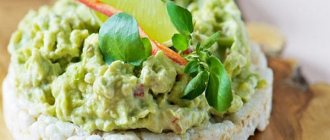Alligator pear, as avocado is sometimes called, contains up to 40% vegetable fat. The pulp of ripe fruits is oily, has a delicate taste, and has beneficial properties. However, you need to know the rules for eating avocado, how to eat it raw, how much you can eat per day and what to combine with to make it tasty.
Unique properties of avocado
The beneficial properties of the fruit pulp are determined by the chemical composition; avocados contain a rich complex of minerals and vitamins. The composition contains a number of useful substances:
- campesterol;
- beta-sitosterol;
- fatty acids (oleic, palmitic, linoleic);
- glutathione;
- niacin;
- thiamine;
- folic acid;
- riboflavin;
- biotin;
- pantothenic acid;
- carnitine
The fruits contain high amounts of antioxidants, vitamin D, protein and fiber. As a result of scientific research, the ability of the fruit to improve the digestibility of other products when consumed together has been revealed. Vegetable fat promotes the breakdown of fat-soluble nutrients (carotenoids, lutein, carotene). Dietary fiber promotes stable functioning of the gastrointestinal tract. Other beneficial properties of the fruit:
- Slow down the effect of toxic substances on the liver. The active compounds contained in the pulp stimulate the synthesis of hormones necessary for the functioning of the liver and slow down its aging. Scientific experiments have revealed a decrease in the effect of toxic substances with the simultaneous consumption of avocados.
- Reduces cholesterol due to the presence of beta-sitosterol. With regular inclusion of the product in the diet, you can reduce the figure to 22%. Monounsaturated fats and folic acid in fruits increase the level of high-density lipoproteins.
- They are a means of preventing the development of diabetes. Fatty acids prevent sudden changes in blood sugar levels. The fruit contains mannoheptulose, this substance stimulates the absorption of glucose by brain tissue, relieves drowsiness, irritability and fatigue. In diabetes, avocado slows down the development of complications associated with the cardiovascular system.
- They improve the function of the heart and blood vessels, normalize blood pressure, reduce the likelihood of heart attack, ischemia, stroke and atherosclerosis.
- They relieve swelling due to their ability to remove excess fluid from the body. This feature is explained by the content of potassium, which has a diuretic effect.
- Reduce the risk of cancer.
- They increase blood clotting due to the vitamin K content and promote wound healing.
- They relieve inflammation and prevent the development of arthritis.
- They have antioxidant properties, enhance collagen production, stimulate oxygen transport into cells, and slow down the aging process. High concentrations of vitamins A and E help smooth out facial and age wrinkles. For psoriasis and eczema, the size of the affected areas is reduced.
- They have a beneficial effect on the organs of vision and prevent the development of cataracts.
- Strengthens bones and tooth enamel due to the phosphorus and calcium content.
- Accelerate metabolism and promote weight loss with moderate consumption.
- Improves blood composition, increases hemoglobin. Copper, iron and vitamin B12 in combination prevent the development of anemia.
- Increases immunity.
- Improve sleep, normalize emotional state and support nervous system function.
- They increase libido and have aphrodisiac properties.
The fruit contains 18 amino acids involved in protein metabolism. With regular consumption of fruits, the functioning of the muscular skeleton is maintained. The active substances in the pulp promote calcium retention and prevent the development of osteoporosis.
Consumption during pregnancy (in consultation with a doctor) prevents congenital defects of the unborn child, builds strong immunity, and serves as a means of preventing the formation of stretch marks on the skin.
Avocado is one of the safest foods in terms of the presence of pesticides. The thick peel of the fruit reliably protects against the penetration of toxic compounds.
When and how much can you give avocados to children?
Increasingly, modern mothers are starting to feed their babies with avocados, even though this fruit is not local in our area. But the composition of the product is so rich, and the texture of its puree is so suitable for small children that these advantages outweigh this disadvantage.
Fruits for complementary feeding are chosen especially responsibly. The fruit must be ripe, of high quality, without signs of spoilage or improper storage. The child's introduction to the product begins with half a teaspoon, monitoring the body's reaction. Gradually increase the portion.
The pulp is made into a puree by mashing it with a fork. If necessary, you can add breast milk or baby formula to the puree. If your child has already tried banana, you can add banana puree to the avocado pulp.
For complementary feeding for a 6-7 month old baby, you can prepare avocado and zucchini puree. Young zucchini is cut into pieces, boiled for 10 minutes in water, then cooled and pureed. The avocado is crushed, then mixed with the cooled zucchini puree.
From 8 months, your baby can be given mashed potatoes made from boiled potatoes, tomato juice and avocado. You can add a little vegetable oil and salt to it.
Note: Dr. Komarovsky believes that avocados can be included in the diet of young children.
If avocado is perceived ambiguously as a product for first complementary feeding, then it is definitely useful for feeding children of early school age because:
- improves the digestion process;
- speeds up metabolism, which is especially useful for overweight children;
- strengthens the immune system;
- helps cope with stress;
- improves heart function;
- improves appetite, which is something parents of little ones should take note of;
- stimulates the development of muscle tissue;
- gives energy for physical activity;
- prevents the development of anemia.
Over the age of 6 years, you can give your child half of the fruit daily. The child can eat it fresh, as part of soups. Many children like crushed puree on toast. You can add fruit slices to pizza toppings.
The use of the product may have contraindications. It is better to consult a pediatrician, especially if the child is prone to allergies. It should not be given to children with latex allergies.
Combining avocados with other foods
The pulp of the fruit has a neutral taste, reminiscent of a mixture of butter and herbs. Some varieties have a nutty flavor. What you eat avocado with depends on individual preferences, but the most successful combinations can be identified:
- Vegetables and fruits. The pulp goes harmoniously with tomatoes, cucumbers, and bell peppers. Often used in cold dishes in combination with Chinese cabbage, corn, and carrots. Added to desserts with bananas and dried fruits. However, it is recommended to give preference to combinations with sweet, sour and sour fruits.
- Seafood. The taste of the fruit is combined with salmon and salmon, in harmony with shrimp, mussels or squid.
- To prepare pastes and sauces, the fatty pulp of the fruit is combined with mustard, pepper, lemon juice, pine nuts and herbs.
- The combination of fruit with soft varieties of cheese gives the dishes an original taste.
The taste of avocado is combined with low-fat protein products, light grains, spices, and piquant heat. When selecting products, you need to take into account the high fat content and calorie content of fruits (about 160 kcal per 100 g). Combination with fatty foods (for example, nuts, cream or pork) can cause discomfort in the digestive tract and, if consumed regularly, leads to weight gain.
The nutritional value
The average weight of an avocado is about 150 grams. But, there are both very small and very large fruits, the weight of which can range from 60 to 500 grams. 100 grams of pulp contains:
- water – 70 grams;
- proteins – 2 grams;
- fats – 15 grams;
- carbohydrates – 8 grams.
The energy value of 100 grams of pulp is 160 calories. Therefore, the energy value of a medium-sized avocado is about 240 calories. This product is high in calories; adding it to people who are on a diet or trying to lose weight is not recommended.
Attention!
The fruit of an evergreen tree contains substances such as folic acid, calcium, magnesium, phosphorus, potassium, and iron. Its moderate consumption promotes skin rejuvenation, improved memory, and increased performance. Medical experts recommend adding it to dishes to prevent hypertension or heart disease.
Rules for eating raw fruit
In order for fruit consumption to be beneficial, when choosing an avocado in a store, you need to pay attention to the absence of cracks and spots on the peel. Such defects indicate deterioration of the product. When pressed with your finger, the surface should be slightly dented.
Hard fruits are tasteless and can only be purchased if you plan to consume them within a few days.
The question of how to properly peel fruit deserves special attention. The preservation of the beneficial properties of the pulp depends on this. The highest concentrations of phytonutrients are found in the thin layer that comes into contact with the peel, so it is important not to remove it with the peel:
- The fruit must be washed with running water.
- Make a longitudinal cut around the bone.
- Taking the halves of the fruit with your hands, you need to twist them in opposite directions, trying to disconnect them from the seed. The core of a ripe fruit comes off easily.
- After removing the seed, each half must be cut into slices and carefully peeled, like from a banana. Another method you can use is to remove the pulp from the peel with a spoon.
- The avocado pit is not eaten. In folk medicine, there are recipes using the seed of the fruit, but use for medicinal purposes requires caution and consultation with a doctor (the seed can cause severe poisoning).
We recommend that you check out Vodka with tangerines
The fruit should be peeled immediately before consumption. A plastic or ceramic knife is used for cleaning; contact with metal accelerates oxidation processes. If you wish, you can eat only part of the fruit; you should not peel the whole fruit. The untouched half should be left in the peel in the refrigerator.
Ripe avocados can be frozen, and using frozen puree to make sauces and appetizers is one way to eat avocados raw.
The pulp is crushed in a blender, lemon juice is added. The mass is whipped and placed in an airtight plastic container. You cannot completely fill the container; free space is necessary, because... When frozen, the mass expands. The product shelf life is 6 months. When frozen, the pulp retains a complex of useful substances.
The fruit can be consumed just like that, choosing the most convenient way:
- there are peeled slices;
- spread on bread;
- scoop out the pulp with a spoon, like ice cream.
Another way to eat avocados is to dice the fruit into halves before peeling them. In this version, pieces of pulp should be removed with a spoon.
To make the product tastier, you can pour olive oil or soy sauce over the pulp, add salt and pepper.
general description
Speaking about how to eat avocado, you should pay attention to the fact that this exotic fruit should be consumed when ripe. By consuming a ripe fruit, you can saturate your body with all the necessary vitamins and elements contained in the composition. When purchasing, you need to pay attention to the appearance. From it you can understand how long the fruit has lain. Avocados are usually sold in the fruit or vegetable departments of supermarkets, as well as on shelves with exotic fruits. Many people wonder how to eat avocados. Everything is very simple - you need to cut the fruit in half, remove the pit, after which it is ready to eat.
Rules for use in dishes
You can eat avocado raw or use it in hot dishes. However, the first option is preferable, because During heat treatment, the pulp acquires a bitter taste due to the tannin content, and beneficial substances lose their qualities.
In cold dishes, the chopped flesh quickly darkens. To avoid this, avocados are sprinkled with citrus juice. The dishes use pulp cut into cubes or slices. To prepare pates and sauces, the fruit is mashed with a fork or crushed in a blender.
The main condition when adding to various dishes is that the fruit must be ripe.
Abundance of dishes with avocado
Restaurant menus often offer delicious avocado dishes that can be prepared at home. The pulp of the fruit can be added to cold appetizers and fruit salads. For example, mix with grapefruit, raspberries, orange and nuts. Avocado is used as a filling for vegetarian sushi, a meat or egg substitute in salads, a base for milkshakes and sweet creams.
Mexican guacamole sauce is prepared from the pulp of the fruit:
- 2 ripe avocados, peeled and mashed in a bowl;
- puree poured over 2 tbsp. lemon juice;
- the chili pepper is seeded and finely chopped;
- half the onion is peeled and chopped;
- pepper, onion and cilantro are added to avocado puree;
- all ingredients are mixed;
- add crushed tomato (with skin);
- All components are salted and mixed.
The sauce can be stored for 3-4 days in the refrigerator.
You can also make puree soup from avocado:
- Peel, chop, and place large ripe fruit in a blender bowl. Then pour in lemon juice.
- Peel and chop the onion and 2 heads of garlic. Finely chop mint and cilantro.
- Add all ingredients to a blender, pour in 350 ml of cooled vegetable broth and mix.
- Add 1 tbsp to the resulting puree. wine vinegar and soy sauce. Add 350 ml vegetable broth.
- Mix all ingredients again in a blender. The thickness can be adjusted by adding cold milk.
- Add salt and pepper to taste and refrigerate.
- Squeeze juice from lime and mix with sour cream or yogurt. Place the mixture on the bottom of the plate, pour in the chilled puree soup.
- Decorate the top of the dish with a sprig of mint and cilantro.
In addition to the classic paste with pepper and salt, you can make a pate from avocado. It is spread on bread, rolls, cookies, toast. Recipe:
- Make a puree from ripe avocado (mash with a fork).
- In a separate container, knead 100 g of tofu or soft cottage cheese.
- The ingredients are mixed and sprinkled with lemon juice.
- Add 2 chopped heads of garlic, salt and 2 tbsp. unsweetened yogurt.
- The ingredients are mixed to a homogeneous paste, which is transferred to a glass container and placed in the refrigerator under the lid.
We recommend that you read: Proper use of dried figs
The shelf life of the paste is 3-4 days.
Avocado is often used in salads with crab meat or shrimp. One of the recipes:
- The pulp of 4 avocados is cut into cubes.
- Peeled shrimp (125 g) are boiled in salted water.
- Low-fat sour cream or yogurt (6 tablespoons) is mixed with the zest of 1 lemon. Pepper and coriander are added.
- Place avocado in a salad bowl and sprinkle with lemon juice. Shrimp are placed on top. The components are mixed. Add sauce to taste.
There are various salad options with the addition of cucumbers, chicken, fish or cheese.
Delicious avocado sauce
It is quite easy to prepare a delicious sauce based on this exotic fruit. It can be served with absolutely any dish. Many people simply spread the prepared mixture on bread instead of butter. A bright shade can decorate any food. To prepare it, you will need:
- 1 medium ripe avocado;
- 1 clove of garlic;
- 3 tablespoons vegetable oil;
- 3 tablespoons cream 10%;
- red chili pepper to taste;
- 1 spoon of lemon juice;
- salt to taste.
The green fruit must be cut into two parts, the pit removed from it, and the pulp separated from the peel. After this, the pulp is crushed with a fork or in a blender. Lemon juice is added to the resulting slurry, as well as the rest of the above ingredients. Beat everything well again in a blender, and then pour the finished mixture into a gravy boat.
Is it possible to eat the fruit with the peel on?
When you first eat the fruit, you may wonder if you can eat the avocado peel. The shell, like the stone, contains persin. This is a toxin that in large quantities causes allergic reactions, impairing the functioning of the digestive tract.
With regular use, it can negatively affect the cardiovascular system.
Only avocado pulp is used for dishes.
How much can you eat per day
If you don't have an allergy, you can eat avocado every day. If you want to lose weight, you need to take into account that 1 fruit weighs about 200 g and can contain up to 400 kcal. In order to replace other fat-containing foods, you can eat 1 piece or 2 small fruits per day (the norm for an adult), however, with a full diet, it is recommended to limit yourself to half a fruit. In this case, there will be no risk of weight gain.
During pregnancy, the product is included in the diet with the permission of a doctor, 1 or 2 slices.
Children over 1 year old can be given 1 tsp of avocado. per day (with the permission of the pediatrician). The amount increases gradually, by the age of 3 it is 0.5 of a whole fruit.
Breakfasts with avocado
Eating avocado for breakfast stimulates metabolism, replenishes energy reserves, and keeps you feeling full for 4-6 hours. Morning meals with fruit pulp are part of many healthy eating programs, as they promote weight loss and saturate the body with useful substances.
Nutritionists consider morning the most successful time to eat fruits. Some diets include dividing the daily intake for breakfast and dinner.
One of the simple breakfast options is toast with chopped pulp, low-fat cottage cheese and herbs (combinations with cheese, vegetables, and dietary meat are possible). A combination of avocado and egg is suitable for breakfast.
Some examples:
- Fresh avocado puree is placed on a fried slice of bread, and an egg fried in a frying pan is placed on top. The sandwich is decorated with greens.
- Toasted mini waffles are complemented with scrambled eggs, grated cheese, chopped tomato and the pulp of half an avocado. The special feature of the dish is the addition of 1 jalapeno.
- Hard-boiled eggs are kneaded. Prepare puree from 1 avocado and mix with dietary mayonnaise. All components are combined, chopped cilantro and seasonings are added. The pasta is spread on the bread and another slice of bread is placed on top to make a sandwich.
- Avocado puree, green adamame beans are placed on gluten-free bread and pieces of avocado pulp with mint leaves are placed on top.
There are recipes for omelettes, pancakes and casseroles with avocado, but in such versions the fruit will be bitter and give a specific taste.
Smoothies can be considered one of the most popular morning dishes. In any of the presented options, all ingredients are placed in a blender and mixed until smooth:
- The pulp of half an avocado, 2 cucumbers, a handful of spinach (can be replaced with kale or chard) pour 2 tbsp. linseed oil, 0.5 tbsp. water, 0.25 tbsp. almond milk, 1 tbsp. lime juice. Sea salt is added.
- Peeled avocado and banana halves, 1 tsp. honey, 1 tbsp. flax seeds are poured with 200 g of filtered or coconut water.
- Whole peeled avocado, almond milk (150 ml), 5 g mint leaves, 1 tbsp. coconut oil, 2 tbsp. cocoa or grated chocolate mixed with spinach leaves and 3 tbsp. coconut sugar or honey. Ice is added.
- Water, spinach, 2 types of berries (blueberries, raspberries, blackberries or blueberries) 1 tbsp. mixed with 1 banana, 1 kiwi and half an avocado.
- A third of an avocado, half a banana, strawberries (12 berries) are filled with water.
Each option differs in calorie and fat content, and is selected taking into account individual preferences.
What can you cook
There are simple and delicious salads with avocado. For those who want to lose excess weight, as well as saturate the body with essential vitamins and microelements, you can prepare a special dish. This includes a dietary salad.
The following ingredients are required:
- half an avocado;
- egg;
- fresh or pickled cucumber;
- 50 g green onions;
- 20 g olive oil.
The salad recipe is simple to implement. Boiled egg and cucumber cut into cubes. Chop the onion. Before serving, add chopped avocado to the salad and season with olive oil. This is done to prevent the fruit from turning black.
The result is a low-calorie dish. It is perfect for people who want to lose weight.
What to cook with avocado quickly and tasty? Sandwich components include:
- fresh bread or crispy toast;
- crushed fruit pulp;
- salmon;
- hard cheese.
Spread the resulting mass onto bread. Place salmon on top. Grate the cheese onto a coarse grater and sprinkle on the sandwich. Thanks to avocado, the taste of salmon becomes especially delicate.
You can make soup from the fruit, which is tasty and nutritious. The cooking process is simple. The following ingredients are required for the soup:
- chicken broth - 1 liter;
- one avocado;
- 2-3 cloves of garlic;
- greenery.
Peel the fruit and grind it in a blender. Add broth. Beat the resulting mixture until smooth and cool. Before serving, add fried onions and herbs to the plate.
Mexican tortillas are among the original spicy snacks. To prepare this dish you need to use the following products:
- 2-3 pcs. sweet pepper;
- 20 large shrimp;
- avocado;
- 20 g lime juice;
- 1 tbsp. spoon of olive oil;
- spices;
- 4 thin flatbreads.
Make a paste from half an avocado, 2 peppers and 4 shrimp. Add olive oil, lime juice and spices to the mixture. Spread this mixture onto the flat cakes. Place the remaining peppers, avocado, and shrimp on tortillas. Roll them into cones.
Eating the fruit at night
Nutritionists have different opinions regarding eating avocados at night. The pulp of the fruit has a high energy value and a large amount of plant fibers, which ensure the absence of hunger for a long time. From this point of view, fruit can replace a hearty dinner.
However, due to the individual characteristics of the digestive organs, liver and pancreas, a large amount of vegetable fats can cause a feeling of heaviness. Eating large quantities of fruit at night can cause insomnia.
If there are negative effects, it is recommended to eat avocados in the morning or during the day. If you feel well, it is better to eat fruit 2-3 hours before bedtime so that dinner has time to digest.
In the evening, you can use light meal options, such as smoothies or sandwiches with fruit pulp. The main condition is the absence of fatty, salty and smoked ingredients in the recipe. Evening meal options:
- Wash and tear arugula (100 g) into pieces, place in a salad bowl. Peel, slice and sprinkle a whole avocado with citrus juice. Cherry tomatoes (10 pcs.), cut in half. Mix all ingredients. Add 1 tbsp. vegetable oil, balsamic and soy sauce. Season the salad with salt and pepper.
- Chicken fillet (low-fat, 200 g) cut, boil. Place onion and bell pepper (cut into cubes) into the prepared broth. Bring the soup to a boil, cool. Add the pulp of 5 avocados, lemon juice, coriander, and grind in a blender to obtain a puree soup. Then add salt to taste.
We recommend that you familiarize yourself with Pine at home
Buddha bowl is another evening dish option. The preparation is as follows:
- Boil buckwheat.
- Season the chicken breast with salt and pepper and fry on both sides. After cooling, cut the fillet into slices.
- In a separate container, chop Chinese cabbage, add thin onion half rings and grated carrots. Salt the salad and add olive oil.
- To prepare the sauce, cut half of the avocado into pieces, pepper, add olive oil, garlic, lemon juice. Grind all ingredients in a blender until pureed. Season the mixture with pepper and salt.
- Cut feta cheese, olives and tomatoes into pieces. Cut the unused half of the avocado into slices and sprinkle with citrus juice.
- You can start assembling the dish. Buckwheat is laid out on a plate, vegetable salad, chicken breast, cheese, tomatoes and avocado are laid out on top. The sauce is placed on top.
Another dinner option is a fat-burning cocktail. To prepare it, chop the flesh of 1 avocado and add 50 ml of frozen low-fat yogurt. Add the juice of half a lime to the ingredients, 1 tsp. cane sugar or sweetener. All components are crushed with a blender; if desired, you can add pieces of ice. The finished cocktail is poured into a tall glass, which is decorated with a slice of avocado.
Is it possible to eat darkened fruit?
The suitability of a fruit for consumption is assessed by the appearance of the pulp. The presence of black dots and darkened areas inside the fruit indicates that the fruit is overripe due to violation of storage rules or improper transportation. Fruits spoil due to excess moisture, prolonged exposure to low temperatures, or sudden changes in climatic conditions. Whether a darkened avocado can be eaten depends on the area of the dark areas. If they do not occupy more than 10% of the surface and are located far from the bone, then they can be cut off with a spoon or the tip of a knife.
It is better not to eat overripe fruit, because the pulp of such avocados is bitter. The fruit is not suitable for consumption if the black spot is located around the pit on both halves and extends throughout the depth of the pulp. This is a sign of rotting that has begun. In this situation, it is not possible to remove the damaged areas; such fruit loses its taste and beneficial properties, and cannot be used for cooking.
Darkening of the surface of the flesh of cut fruit is normal. In this case, the dark coating can be removed with a knife. The unused part of the fruit should be stored together with the pit and peel, this will slow down oxidation. You can also lubricate the cut of the fruit with olive oil. Another way is to place a chopped onion on the bottom of the container.
Ripe fruit should be stored in the refrigerator for no more than 5 days, wrapped in cling film or placed in a container (zip-lock bag). The cut fruit should be stored in the refrigerator at the back wall, where the temperature is lower.
How to choose?
Alligator pear fruits are imported into Russia from Israel, Mexico, and Spain. In order to deliver fresh fruits to grocery stores, they are often picked from trees half-ripe. But how to choose this fruit correctly? First of all, you should press a little on the avocado skin with your fingers. If it is hard, then this indicates that the fruit is unripe. In such situations, the fruit must be left at a temperature of about 25 degrees to ripen. If the surface of the avocado is too soft, there are dark spots on the skin, and dents remain after pressing, then this indicates that the product is unsuitable for consumption. As for size, it is best to choose fruits up to 10 cm long.
Is it possible to eat unripe fruit?
The pulp of unripe fruit has a bitter taste and is tough. It contains a toxic compound that can cause symptoms of poisoning or digestive upset. The peel of unripe fruits has a green tint (when ripe it becomes yellowish and brown).
Unripe fruits are not suitable for cooking; eating them will not bring pleasure. To ripen, the fruits should be marked in a paper bag for 3-5 days and left at room temperature. To speed up the process, you can add an apple or banana along with the avocado, which actively release ethylene. The gas is retained in the bag and stimulates the rapid ripening of the avocado.
Who should not eat avocado?
Due to the rich chemical composition of the fruit, the question often arises of who should not eat avocados. The fruit is an exotic product, so when you first consume it, you need to monitor your health and allergic symptoms (cough, nasal congestion, swelling, eczema, itching). You should not eat avocado if you have an individual intolerance. If you are sensitive to latex, the fruit should not be consumed, because this compound is included in the product. There are other contraindications:
- When breastfeeding, it is recommended to exclude avocados from the diet, because. If the active substances get into milk, they can cause allergies in the child.
- Caution must be exercised in case of impaired functions of the digestive tract, liver, kidneys, and pancreas. Vegetable fats and fibers can cause diarrhea and stomach pain.
During pregnancy, there are no direct contraindications to eating avocado, if the fruit did not cause negative reactions before conception. However, due to the content of a large amount of vitamins and phytosterols, you must be careful and coordinate your intake with your doctor. With the simultaneous administration of vitamin complexes, an overdose is possible. You should not turn on this product for the first time while pregnant.
Eating avocado helps increase blood clotting, so use with caution when there is congestion in the blood vessels or a tendency to form blood clots. In case of chronic diseases, in old age, during treatment with blood thinning drugs, the inclusion of fruit in the diet must be agreed with the attending physician.
Moderate consumption of fruits will bring benefits and avoid negative reactions.











